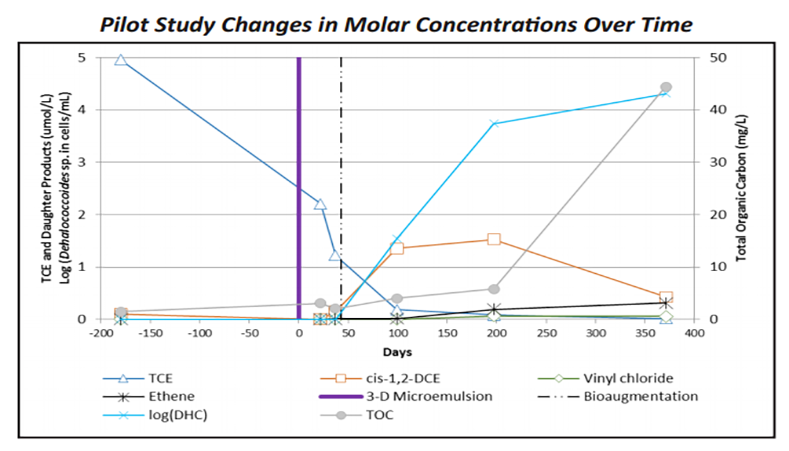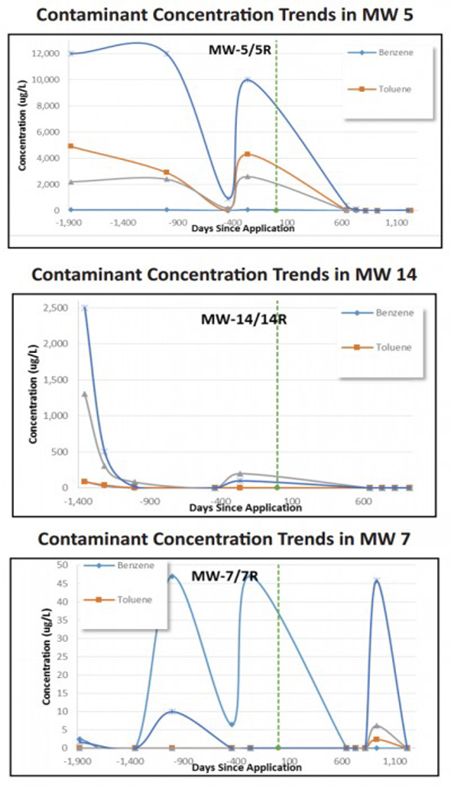Remediation at Multiple Service Stations using Badger Application System
RegenOx® Applied to Three Long Island Sites Contaminated with High BTEX Levels
Project Highlights
- BTEX levels higher than 20 mg/L observed on-site.
- Badger Injection System allowed for high volume applications of up to 700 gallons per injection point.
- In Situ chemical oxidation (ISCO) using 56,400 pounds of RegenOx® was used at three service station sites.
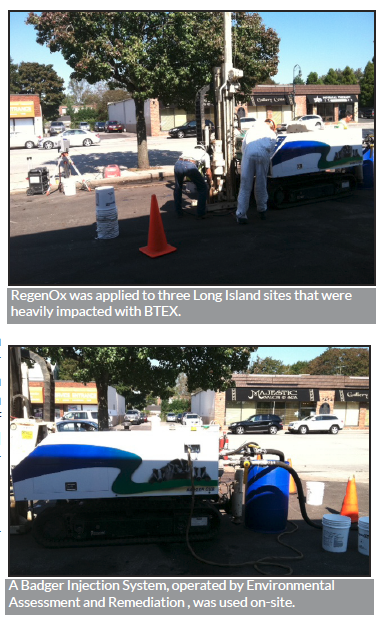
Project Summary
Several service station sites in Long Island, N.Y. were contaminated with high levels of BTEX. In heavily impacted areas, BTEX levels were higher than 20 mg/L. RegenOx was applied to the sites using the Badger Injection System, which is operated by Environmental Assessment and Remediation (EAR). The Badger injection process is used to deliver large volumes of reagent to targeted treatment zones. The objective is to obtain widespread distribution of reagent. Typical injection volumes are 500 to 700 gallons per injection point.
Remediation Approach
The Long Island sites range in size from 600-square-feet to over 4,000-square-feet.
Injection Amounts:
- Site 1 – 30,000 pounds of RegenOx; 4 Injection Events
- Site 2 – 24,000 pounds of RegenOx; 3 Injection Events
- Site 3 – 2,400 pounds of RegenOx; 2 Injection Events
Technology Description
RegenOx is an advanced chemical oxidation technology that destroys contaminants through powerful, yet controlled direct oxidation and free-radical reactions. This product maximizes in situ performance through the use of a solid alkaline oxidant (a sodium percarbonate complex) and a multi-part catalyst. These oxidation reactions do not inhibit natural bacterial populations and are compatible with biological treatment methods.
Regulatory Goals Met in 30 Days in Complex Industrial Dry Cleaner Plant Remediation
Project Highlights
- PCE contaminant concentrations met remediation goals within 30 days post-application
- No rebound post-application
- Remediation goals met for site closure submittal
1m 57s reading time
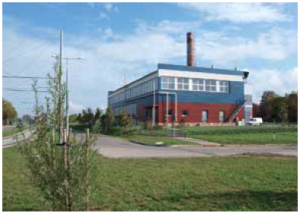
Project Summary
An industrial dry cleaning plant in West Allis, Wisconsin was equipped with multiple underground storage tanks (USTs) which stored the degreasing agent perchloroethylene (PCE). The UST releases date back to 50 years and created a treatment area of approximately 4,500 square feet. An in situ, combined remedies treatment approach was implemented onsite using a range of reagents including PlumeStop®, RegenOx®, Hydrogen Release Compound (HRC®) and BioDechlor INOCULUM Plus (BDI® Plus). This site was planned for future development, consequently the remediation approach was designed to achieve site closure by removing the residual source in the vadose zone and treating the deep groundwater plume.
Remediation Approach
Starting in the residual source area, in situ chemical oxidation (ISCO) was applied via soil mixing down to a depth of 7 ft. below ground surface. The ISCO program using RegenOx was designed to treat a total of 140 tons of PCE-impacted clay soil with initial concentrations measuring 169 mg/kg and a remediation goal of <14 mg/kg. To address the deep groundwater plume with PCE concentrations as high as 13,800 ppb, fast-acting, PlumeStop was applied through a series of deep injection wells approximately 80 to 95 ft. below ground surface. The use of PlumeStop allows remediation practitioners to quickly reduce concentrations over a wide-area with the long-term assurance of biodegradation. HRC and BDI Plus were co-applied with PlumeStop to enhance the biodegradation process.
Technology Description
RegenOx is an advanced chemical oxidation technology that destroys contaminants and maximizes in situ performance while using a solid alkaline oxidant that employs a sodium percarbonate complex with a multi-part catalytic formula.
PlumeStop is an innovative in situ remediation technology designed to rapidly reduce contaminant concentrations, stop migrating plumes, eliminate contaminant rebound, achieve stringent clean-up standards, and treat back-diffusing contaminants.
HRC is a controlled release, electron donor material, highly efficient for the production of dissolved hydrogen to fuel anaerobic biodegradation processes in soil and groundwater.
Bio-Dechlor INOCULUM Plus is a species of Dehalococcoides sp. (DHC), enriched to increase its ability to rapidly dechlorinate contaminants during in situ bioremediation processes.
Results
The ISCO application of RegenOx, and combined approach using HRC, BDI Plus and PlumeStop rapidly reduced contaminant concentrations to achieve the remediation goal in just 30 days post-application. As a result, the client has submitted for site closure. Using an innovative combined remedies approach provides environmental remediation professionals with an effective solution for treating sites that present multiple challenges including hard to treat contaminants, sites with lengthy history of impacted soils, difficult geologies, and time constraints.
Free-Phase Hydrocarbons Significantly Reduced on Historic Spill Site Within Four Months
Project Highlights
- PetroCleanze™ applications combined with High Vacuum Dual-Phase
Extraction (HVDPE) reduced site contaminant mass and totally eliminate
free-phase hydrocarbons within four months - TPH concentrations reduced by over 97% at key monitoring well
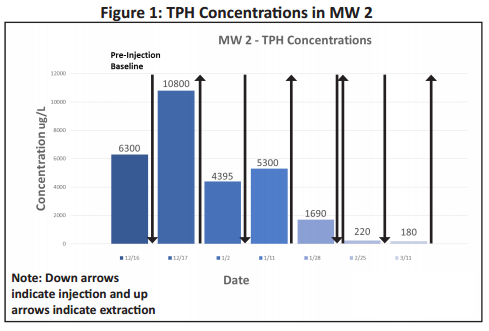
Project Summary
A leak from an above ground diesel tank caused groundwater contamination, including free-phase and dissolved hydrocarbons, and significant bound hydrocarbon mass at this manufacturing site. Remediation efforts conducted for nearly a decade included excavation, freephase hydrocarbon recovery, groundwater treatment, bio-venting, high-vacuum dual-phase extraction (HVDPE), and chemical oxidation. However, a free-phase hydrocarbon layer still existed over much of the site as indicated in key monitoring wells.
REGENESIS® recommended the use of PetroCleanze to desorb bound hydrocarbons from the plume area, which was the source of the reoccurring freephase layer. A design was developed that included a regimen of PetroCleanze injections and HVDPE events to desorb and recover the bound hydrcarbons still existing on the site, which would then be recovered by use of the existing HVDPE system.
A total of 107,000 gallons of PetroCleanze was applied through 57 injection points in a grid pattern. Four injection events occurred over the course of four months at depths of 19-27 feet below ground surface. HVDPE was conducted between injection events to recover desorbed hydrocarbon mass.
Technology Description
PetroCleanze is a customized formulation of the widely used RegenOx in situ chemical oxidation technology. The primary function of RegenOx PetroCleanze is to increase the desorption rates of hydrocarbons bound in saturated soil and make them available for more efficient and rapid treatment using a range of enhanced recovery technologies.
Results
Following treatment of the site with PetroCleanze, combined with HVDPE, groundwater hydrocarbon contamination was significantly reduced, as evidenced by a 97% reduction at key monitoring well MW-2 (See Figure 1). The consulting firm leading the project is currently performing quarterly monitoring ahead of petitioning for site closure.
Sequential Anaerobic and Aerobic Treatment of Chlorinated Solvents Achieves MCLs
Project Highlights
- All target compounds reduced to below Maximum Contaminant Level (MCLs) in onsite wells
- Anaerobic biodegradation using Hydrogen Release Compound (HRC®) treats tetrachloroethylene (PCE) and 1,1 dichloroethene (DCE) to below federal MCLs
- Aerobic biodegradation using ORC Advanced® treats vinyl chloride (VC) and 1,1-DCE to below MCLs
- ORC Advanced provided oxygen for a period of 15 months in the target treatment zone
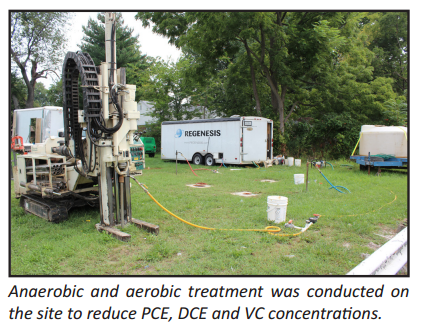
Project Summary
The site is located in the Coastal Plain of South Carolina and is a former light industrial facility. Baseline concentrations of total chlorinated VOCs – which included PCE, dechlorination daughter products, and 1,1- DCE – were as high as 2,000 μg/L in the near-source groundwater.
Initial groundwater treatment injected 2,400 pounds of HRC at the site using direct push technology. VOC concentrations in the target monitoring wells decreased to below federal MCLs for all contaminants except for VC and 1,1-DCE, which appeared to have stabilized between 10-15 μg/L and 7-30 μg/L, respectively.
In an attempt to meet the MCLs for all contaminants and attain regulatory closure, the treatment approach was shifted to aerobic bioremediation to accelerate degradation of residual VC and 1,1-DCE. This approach was based on evidence that aerobic biodegradation of daughter products such as VC can be much faster than anaerobic processes. The aerobic treatment involved injection of 1,360 pounds of ORC Advanced via direct push technology into 22 temporary points.
Technology Description
ORC Advanced is a proprietary formulation of food-grade, calcium oxy-hydroxide that produces a controlled-release of molecular oxygen to enhance aerobic biodegradation.
HRC is a controlled release, electron donor material that, when hydrated, is specifically designed to produce a controlled release of soluble lactate. The newly available lactic acid is highly efficient for the production of dissolved hydrogen to fuel anaerobic biodegradation processes in soil and groundwater.
Results
After initial groundwater treatment of HRC and following application of ORC Advanced, groundwater monitoring showed reductions in VC to below MCL except for periodic detections between 2-3 μg/L and reductions in 1,1-DCE to below the MCL of 7 μg/L onsite. The VOC concentrations and the dissolved oxygen levels demonstrated that ORC Advanced released oxygen for 15 months in the target treatment zone.
Bedrock Treatment Remediates NJ Manufacturing Facility
Project Highlights
- 3-D Microemulsion injections created 30-foot ROI in fractured bedrock
- TCE concentrations reduced through reductive dechlorination and daughter products reduced to ethene within 12-month study
- Pilot study results allowed for: full-scale design, maximized product ROI, minimized bedrock injection well drilling, and resulted in reduced overall project costs
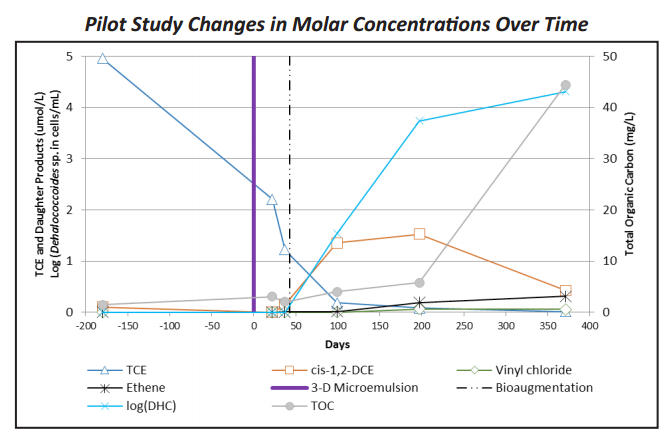
Project Summary
Previous manufacturing activities impacted a fractured bedrock aquifer with TCE. The plume migrated approximately 600 feet downgradient along fractures at 70-80 feet (shallow) and 105-115 feet (intermediate) below ground surface. Remediation at the site was planned as a phased approach including a source area pilot evaluation of enhanced reductive dechlorination, bioaugmentation, and radius of influence (ROI). A larger source area treatment and property boundary barrier was to be determined based upon the pilot study results.
The pilot study found that injection of 3-D Microemulsion was capable of initially influencing a 30-40 feet ROI based on visual (turbidity) and geochemical data. Over a 12-month period, TOC levels remained elevated at concentrations above 10 mg/L at a shallow well 20-feet away. At the two intermediate wells 40-feet away, TOC concentrations increased to >40 mg/L during this period. During this same pilot study period, TCE concentrations decreased, cis-1,2-DCE concentrations increased then attenuated, and VC and ethane concentrations increased. Bioaugmentation, occurring 6 weeks after the 3-D Microemulsion injection resulted in Dehalococcoides sp. populations that increased and sustained at elevated concentrations (104 cells/mL).
Remediation Approach
Injections of 3-D Microemulsion were introduced by packer into 2 injection wells across four 10-foot fracture intervals (60-115 feet bgs). Monitoring was conducted in two shallow bedrock wells at 70-80 feet bgs and two intermediate bedrock wells at 105-115 feet bgs. ROI monitoring was conducted at these four monitoring wells that were located 20 feet, 40 feet, and 55 feet away from the injection wells. Bioaugmentation was performed 6 weeks after 3-D Microemulsion injections. Full-scale treatment is planned, which will include a larger treatment in the source area and a downgradient barrier at the property boundary.
Technology Description
3-D Microemulsion is an engineered electron donor technology that offers a novel 3-stage electron donor release profile pHneutral chemistry, and unique subsurface distribution properties.
Roadside Fuel Transport Spill Treated with Combined Remediation Approach
Project Highlights
- Combined remediation approach treats contaminants that remained following emergency excavation
- RegenOx® and ORC Advanced® selected to eliminate need for dedicated groundwater treatment infrastructure
- BTEX levels reduced by 97% to below non-detect levels in the two highest concentration wells
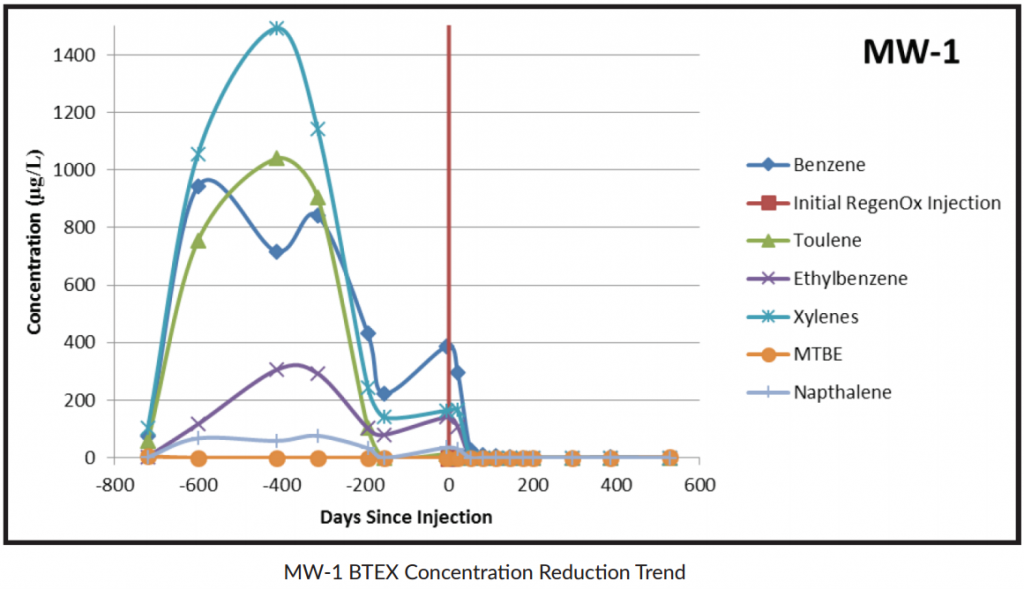
Project Summary
A rural site located in south-central North Carolina required remediation to treat petroleum contamination from an overturned tanker truck. Excavation activities during an emergency response removed much of the contaminant mass, however additional contamination in soil and groundwater remained after the excavation was completed.
In the two highest-concentration wells, total BTEX averaged more than 1,300 μg/L in the four quarterly groundwater monitoring events prior to treatment.
A combined chemical oxidation and aerobic bioremediation treatment was employed to eliminate the need for dedicated groundwater treatment infrastructure at this roadside location to advance the site to regulatory closure.
The products selected were RegenOx, an in situ chemical oxidant, and ORC Advanced, an enhanced aerobic bioremediation product. The treatment covered a 3,900-square-foot area through 30 direct-push injection points in the former spill area.
Technology Description
RegenOx is an advanced chemical oxidation technology that destroys contaminants through powerful, yet controlled chemical reactions. This product maximizes in situ performance while using a solid alkaline oxidant that employs a sodium percarbonate complex with a multi-part catalytic formula.
ORC Advanced is a proprietary formulation of food-grade, calcium oxy-hydroxide that produces a controlled-release of molecular oxygen for periods of up to 12 months upon hydration.
Results
Within 18 months of treatment, the site was under natural attenuation monitoring prior to regulatory closure with five of the six wells already below stringent regulatory requirements.
Excavation Treatment Reduces Contamination Below Clean-Up Target Levels
Project Highlights
- Remediation activities included excavating a 1,600-square-foot area contaminated with BTEX and TPH.
- ORC Advanced Pellets applied on-site to stimulate aerobic biodegradation during backfill activities.
- Two monitoring wells reduced to below groundwater contaminant targets.
Project Summary
The Bryant Grocery and Saw Co. site in the Florida Panhandle was the subject of excavation activities to remediate significant BTEX and TPH contamination as a result of historical releases from gasoline underground storage tanks (USTs). Excavation activities were planned for an area of approximately 1,600-square-feet to a depth of 14 feet below ground surface.

Remediation Approach
During backfill activities, ORC Advanced Pellets were added to provide a long-term source of oxygen to promote aerobic biodegradation of residual, dissolved-phase petroleum constituents remaining in the excavation area. A total of 520 pounds of ORC Advanced Pellets were applied to the saturated zone of the excavation. Both MW-7R and MW-14R have seen BTEX, TRPH, and MTBE reduced to stringent groundwater quality standards for Florida (Groundwater Contaminant Target Levels, or GCTLs). In MW-5R, Total Residual Petroleum Hydrocarbons (TRPH), MTBE, benzene, and ethylbenzene have been reduced to below GCTLs. Toluene and xylenes concentrations remain slightly above GCTLs but have declined by more than 99% related to both constituents.
Technology Description
Advanced Formula Oxygen Release Compound (ORC Advanced®) is a proprietary formulation of food-grade, calcium oxy-hydroxide that produces a controlled-release of molecular oxygen for periods of up to 12 months upon hydration
Single PersulfOx® Treatment Reduces MTBE Concentrations by 50 Percent
Project Highlights
- Both PersulfOx and NaOH activated persulfate used on-site to test effectiveness
- Single injection event of PersulfOx resulted in 50% reduction of MTBE
- Backfilled gravel excavation used as a treatment cell for contaminant mass migrating from an inaccessible dispenser canopy toward the property boundary
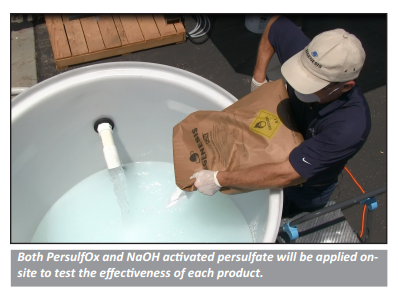
Project Summary
A gas station in the Washington DC metro area was contaminated with BTEX and MTBE following a release from a dispenser island. High concentrations of MTBE (160 ppm) diffused into the native silty clay and beyond the property boundary. Two persulfate chemistries utilized at the site to evaluate treatment longevity. Persulfate test kits demonstrated that PersulfOx remained active for six months. The PersulfOx® injections were performed within a downgradient former excavation which was backfilled with gravel to intercept the contaminants. The single injection event of PersulfOx resulted in 50% reduction of MTBE. Treatments in the former excavation have also reduced MTBE concentrations at the property boundary.
Remediation Approach
The PersulfOx injection was performed into three injection wells that were located in an excavation that was backfilled with gravel. This gravel backfilled excavation used as a treatment cell for contaminants originating from under the dispenser canopy (upgradient). The goal was to oxidize contaminant mass as it moves through the former excavation toward the property boundary. The native soils consisted of silty clay, which have a low hydraulic conductivity and do not accept injection volumes easily. This approach treats the petroleum bleed-off from the dispenser canopy before it moves downgradient and eventually off-site. The purpose of the project was designed to evaluate performance data where PersulfOx and NaOH activated persulfate were compared for contaminant reduction trends, longevity, and ease of application.
Technology Description
PersulfOx is a sodium persulfate-based chemical oxidation technology which destroys both hydrocarbon and chlorinated solventtype contaminants in the subsurface. PersulfOx contains a built-in catalyst which activates the persulfate component and generates contaminant-destroying free radicals without the need for the addition of a separate activator.
Residential Property Treated for TPHd Concentrations in Groundwater
Project Highlights
- Excavation and remediation injections performed in a tight residential setting with intense local community involvement.
- Treatment included shoring/excavation, soil handling and off-site disposal, in situ chemical oxidation (ISCO), bioremediation and sewer replacement.
- Groundwater sampling post-remediation indicates an overall decrease in TPHd concentrations and monitoring is ongoing.

Project Summary
An underground heating oil storage tank contaminated the groundwater below a residential property in Northern California. The two-story home, located near a downtown beach community, had a 100-gallon heating oil tank that was removed in 1994. Site investigation and groundwater monitoring activities were conducted since the removal, when apparent petroleum hydrocarbon impacts were identified. TPHd concentrations of 3,300 ug/L were detected on-site.
Remediation proved to be difficult considering the location of the residential property. The home was surrounded by other residences on three of its corners, with a bed and breakfast and swimming school located to the northwest of the property. A tight injection approach was required so the neighboring properties were not disturbed.
Remediation Approach
To meet the objective mass reduction of residual TPHd in both soil and groundwater, the remedial approach combined excavation/shoring and removal of TPHd impacted soils. It also included ISCO using RegenOx® and bioremediation using Oxygen Release Compound (ORC Advanced®). Approximately 233 cubic yards of soil were removed. A total of 2,350 pounds of RegenOx Part A and 1,320 pounds of Regenox Part B, along with 716 pounds of ORC Advanced® in slurry form, was injected into the subsurface via 16 direct-push injections.
Technology Description
ORC Advanced is a proprietary formulation of food-grade, calcium oxy-hydroxide that produces a controlled-release of molecular oxygen for periods of up to 12 months upon hydration.
RegenOx is an advanced chemical oxidation technology that destroys contaminants through powerful, yet controlled chemical reactions and not through biological means. This product maximizes in situ performance while using a solid alkaline oxidant that employs a sodium percarbonate complex with a multi-part catalytic formula.
ORC® Advanced Pellets Utilized as Part of Combined Remedy Approach at Ohio Brownfield’s Project
Project Highlights
- Ohio VAP Certified Professional specified ORC® Advanced Pellets in Remedial Action Plan for purpose of obtaining grant through the Clean Ohio Revitalization Fund (CORF).
- $1.98 million in brownfield’s funding was granted through CORF as a result of Proposed Remedial Action Plan.
- Approximately 18,000 pounds of ORC® Advanced Pellets were applied to the base of 5 former underground storage tank excavation sites to address residual TPH and PAH impacts in groundwater

Project Summary
The site, a former cordage and twine factory in Ohio, was closed in 2004 after 125 years of operation. The city and developer secured $1.98 million in brownfield’s funding through the Clean Ohio Revitalization Fund (CORF). These funds were secured for demolition and remediation activities at the site included but not limited to asbestos removal, underground storage tank removal, and contaminated soil excavation and demolition activities.
Remediation Approach
Approximately 18,000 pounds of ORC Advanced Pellets were specified by the Ohio VAP Certified Professional responsible for this project. Per the CORF remedial plan the pellets were applied to the base of 5 former underground storage tankexcavation sites. As part of this combined remedy approach (excavation + biodegradation), ORC Advanced Pellets were included to promote enhanced aerobic biodegradation of residual TPH and PAH impacts in water for a period of 9-12 months.
Technology Description
ORC Advanced® Pellets (ORC-A Pellets) are a pelletized version of REGENESIS’ widely-used ORC Advanced and are designed specifically for direct application into excavations, tank pits and trenches. This pelletized, dry application material minimizes airborne dust while eliminating the need for specialized equipment and spray water required for powder-slurry applications. ORC Advanced Pellets are approximately 3-10 mm in size.

 Americas
Americas Europe
Europe Français
Français Deutsch
Deutsch Italiano
Italiano Español
Español
